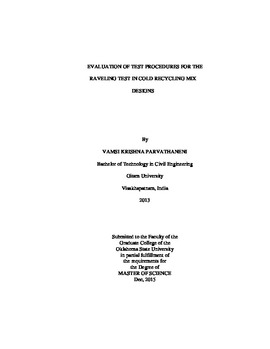| dc.contributor.advisor | Cross, Stephen A. | |
| dc.contributor.author | Parvathaneni, Vamsi Krishna | |
| dc.date.accessioned | 2016-09-29T18:46:13Z | |
| dc.date.available | 2016-09-29T18:46:13Z | |
| dc.date.issued | 2015-12-01 | |
| dc.identifier.uri | https://hdl.handle.net/11244/45373 | |
| dc.description.abstract | Cold In-Place Recycling (CIR) method is one of the forms of asphalt pavement recycling which is environmental friendly and cost effective. With CIR a milling machine removes the asphalt pavement to a depth of 3 to 5 inches. The reclaimed asphalt pavement (RAP) is then sized and mixed with a bituminous recycling agent. Bituminous recycling agents consist of either emulsified asphalts or foamed (expanded) asphalt. The treated RAP is then placed and compacted using conventional asphalt paving equipment. The CIR process recycles 100 percent of the RAP in place without the application of heat.Currently there are no nationally accepted mix design methods for CIR mixtures. The CIR mix design procedures adopted by most state highway agencies originated from mix design procedures developed by equipment and materials suppliers. Most agencies follow the mix design procedures developed by Wirtgen (1) for CIR with foamed asphalt. Most CIR mix designs using emulsified asphalt are based on procedures developed by Road Science and their predecessors. . As per ARRA (2), CIR mix designs with emulsified asphalt consist of evaluating the strength of the recycled mixture using Marshall stability or indirect tensile strength, retained Marshall stability or tensile strength ratio to evaluate resistance to moisture induced damage, and the Raveling test (ASTM D7196) is performed to evaluate the emulsified asphalt�s breaking and curing properties and the mixtures resistance to raveling under initial traffic. Road Science and their predecessors hold a patent on the mix design process and the use of raveling test in combination with other tests. The patents have not been uniformly enforced over the years causing uncertainty about the use of the Raveling test as a part of CIR mix designs, resulting in reluctance on the part of some agencies to use CIR with emulsified asphalts. | |
| dc.format | application/pdf | |
| dc.language | en_US | |
| dc.rights | Copyright is held by the author who has granted the Oklahoma State University Library the non-exclusive right to share this material in its institutional repository. Contact Digital Library Services at lib-dls@okstate.edu or 405-744-9161 for the permission policy on the use, reproduction or distribution of this material. | |
| dc.title | Evaluation of Test Procedures for the Raveling Test in Cold Recycling Mix Designs | |
| dc.type | text | |
| dc.contributor.committeeMember | Lewis, Michael Phil | |
| dc.contributor.committeeMember | Yang, Xiaoming | |
| osu.filename | Parvathaneni_okstate_0664M_14313.pdf | |
| osu.accesstype | Open Access | |
| dc.description.department | Civil Engineering | |
| dc.type.genre | Thesis | |
